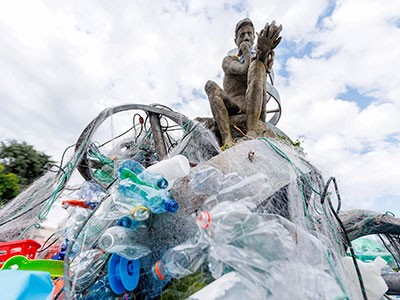When the United Nations negotiations on plastic pollution in Geneva, Switzerland, collapsed in August, observers declared the outcome an abject failure and the process broken. Earlier this month, reports that the chair of the talks, ambassador Luis Vayas Valdivieso, would step down deepened uncertainty.
Trust and science: the essential elements missing from plastics treaty talks
Many media outlets saw a failure of multilateralism, but what I saw was fatigue. Just as the ‘failed’ 2009 Copenhagen climate summit paved the way for the 2015 Paris agreement, this plastics-treaty breakdown could be an inflection point — if we learn the right lessons and rethink the process.
As a researcher of global environmental governance, I have followed the negotiations from the start. I served as an adviser on Rwanda’s delegation in 2022, when it co-sponsored the UN Environment Assembly resolution to end plastic pollution. Since 2023, I have led the observer delegation of Northeastern University in Boston, Massachusetts. During this time, I have watched nations debate the treaty’s scope, restating positions with little progress. But individuals from every country tried to keep faith in the process.
The negotiations have stalled partly because a false morality play of ambition versus obstruction took hold. Over the years, I have witnessed how this ‘heroes versus villains’ narrative has obscured the complex realities at stake.
But the story is never that simple. From the outset, nations disagreed on what ending plastic pollution meant. For some, it was about improving waste management, recycling systems and circular economies. For others, it meant curbing the manufacture of primary polymers. That ambiguity set into a geopolitical divide. For some nations, plastics manufacturing underlies economic survival and political stability. For small island states and vulnerable coastal areas, plastic pollution threatens human survival. Yet every country must protect its ecosystems.
Environmental treaties are paralysed — here’s how we can do better
Despite clear science and mounting public pressure, negotiations became mired in the politics of survival — between nations concerned about the economic realities and the countries most affected by the ecological urgencies. I spoke to Vayas Valdivieso, who reflected on “the magnitude of the talks, given the implications — for the environment, health and the economy”. Negotiating a treaty that touches every country and spans energy, trade, chemical and waste sectors by 2024, in just two years, was politically ambitious and procedurally unrealistic — a timeline that increased complexity and hardened positions.
Negotiators must acknowledge the economic realities that underpin resistance and the ecological urgencies that demand change. Historically, the UN Environment Programme (UNEP) has provided an architecture for environmental diplomacy — with the authority to convene but not to command. It must revive its role as an impartial steward for conveying reliable scientific data, and for creating structures and spaces in which states can seek alignment. Furthermore, it must help to provide financial, institutional and technological support for collective action.
Despite divisions, all parties converge around sustainable product design, resource efficiency, waste management and circular-economy principles. Now, we need what I call radical incrementalism: a bold vision coupled with practical phased steps. The 1987 Montreal Protocol to protect the ozone layer, championed by UNEP, offers such a model. When negotiations resume, three immediate actions can help.




